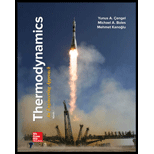
Concept explainers
Which is a more valuable resource for work production in a closed system −15 ft3 of air at 100 psia and 250°F or 20 ft3 of helium at 60 psia and 200°F? Take T0 = 77°F and P0 = 14.7 psia.
The more valuable resource for work production in a closed system; air or helium.
Answer to Problem 29P
The air has the more valuable resource for work production in a closed system.
Explanation of Solution
Express the mass in the system.
Here, mass is
Express the entropy change between the given state and dead state.
Here, entropy change between the given state and dead state is
Express the specific volume at the given state.
Express the specific volume at dead state.
Express the specific closed system exergy.
Here, specific internal energy is
Express the total exergy available for the production of work.
Here, mass is
Conclusion:
Solve for AIR:
Refer Table A-1E, “molar mass, gas constant and critical point properties”, and write the gas constant of air.
Refer Table A-2E, “ideal gas specific heats of various common gases”, and write the properties of air.
Substitute
Substitute
Substitute
Substitute
Substitute
Substitute
Solve for HELIUM:
Refer Table A-1E, “molar mass, gas constant and critical point properties”, and write the gas constant of helium.
Refer Table A-2E, “ideal gas specific heats of various common gases”, and write the properties of helium.
Substitute
Substitute
Substitute
Substitute
Substitute
Substitute
On comparing the total exergy available for the potential of work from Equations (VII) and (VIII), it is obtained that air has more potential.
Hence, the air has the more valuable resource for work production in a closed system.
Want to see more full solutions like this?
Chapter 8 Solutions
Thermodynamics: An Engineering Approach ( 9th International Edition ) ISBN:9781260092684
- Q5:(? Design the duct system of the figure below by using the balanced pressure method. The velocity in the duct attached to the AHU must not exceed 5m/s. The pressure loss for each diffuser is equal to 10Pa. 100CFM 100CFM 100CFM ☑ ☑ 40m AHU -16m- 8m- -12m- 57m 250CFM 40m -14m- 26m 36m ☑ 250CFMarrow_forwardA mass of ideal gas in a closed piston-cylinder system expands from 427 °C and 16 bar following the process law, pv1.36 = Constant (p times v to the power of 1.36 equals to a constant). For the gas, initial : final pressure ratio is 4:1 and the initial gas volume is 0.14 m³. The specific heat of the gas at constant pressure, Cp = 0.987 kJ/kg-K and the specific gas constant, R = 0.267 kJ/kg.K. Determine the change in total internal energy in the gas during the expansion. Enter your numerical answer in the answer box below in KILO JOULES (not in Joules) but do not enter the units. (There is no expected number of decimal points or significant figures).arrow_forwardmy ID# 016948724. Please solve this problem step by steparrow_forward
- My ID# 016948724 please find the forces for Fx=0: fy=0: fz=0: please help me to solve this problem step by steparrow_forwardMy ID# 016948724 please solve the proble step by step find the forces fx=o: fy=0; fz=0; and find shear moment and the bending moment diagran please draw the diagram for the shear and bending momentarrow_forwardMy ID#016948724. Please help me to find the moment of inertia lx ly are a please show to solve step by stepsarrow_forward
- My ID# 016948724arrow_forwardPlease do not use any AI tools to solve this question. I need a fully manual, step-by-step solution with clear explanations, as if it were done by a human tutor. No AI-generated responses, please.arrow_forwardPlease do not use any AI tools to solve this question. I need a fully manual, step-by-step solution with clear explanations, as if it were done by a human tutor. No AI-generated responses, please.arrow_forward
 Refrigeration and Air Conditioning Technology (Mi...Mechanical EngineeringISBN:9781305578296Author:John Tomczyk, Eugene Silberstein, Bill Whitman, Bill JohnsonPublisher:Cengage Learning
Refrigeration and Air Conditioning Technology (Mi...Mechanical EngineeringISBN:9781305578296Author:John Tomczyk, Eugene Silberstein, Bill Whitman, Bill JohnsonPublisher:Cengage Learning Principles of Heat Transfer (Activate Learning wi...Mechanical EngineeringISBN:9781305387102Author:Kreith, Frank; Manglik, Raj M.Publisher:Cengage Learning
Principles of Heat Transfer (Activate Learning wi...Mechanical EngineeringISBN:9781305387102Author:Kreith, Frank; Manglik, Raj M.Publisher:Cengage Learning

